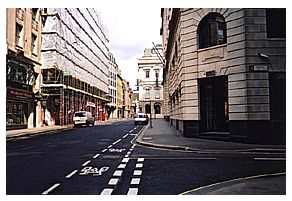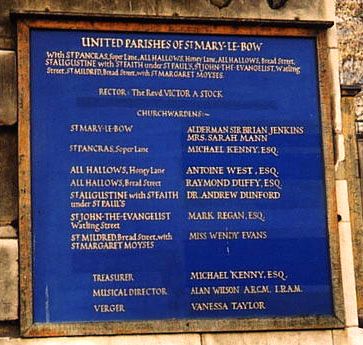The Location of Soper Lane
Although there is no longer a London street named Soper Lane, the location of the medieval road is known from references both to the street itself and to St. Pancras Church, which stood on the corner of Soper Lane and Needlers Lane. Both Soper Lane and St Pancras Church suffered considerable damage during the Great Fire of 1666.
In 1598 the historian John Stow published a ward by ward survey of London streets and parish churches. In preparing his survey he studied a number of primary sources and he also walked through the streets checking his sources against existing roads. He quotes widely from the description of London written by William Fitzstephen in 1174.
In more recent times both Charles Pendrill and Alan Stapleton have referred to Soper Lane and St. Pancras Church in their books about medieval London. The Historical Gazetteer of London before the Great Fire produced by Keene and Harding is a further source of information concerning property in this area.
The references indicate that Soper Lane was:
1. Intersecting Needler’s Lane.
2. At one end of Cheape.
3. West of Walbrook and east of Bow Lane. West of St. Sithes Lane.
4. Beside St. Pancras Church, opening off the south side of Cheape.
5. West of Needler’s Lane and West of St. Pancras Church, turning up to
Cheape.
6. East of the stone cross in West Cheape.
7. Beside St. Pancras Church.
8. Intersecting with Cheape.
9. By what is now Pancras Lane.
Putting together all of these references, correlating them with the surviving medieval streets and their names and superimposing them on a modern map of the area it is possible to confirm that the northern end of the modern Queen Street follows the course of the medieval Soper Lane.
Alan Stapleton in his book London Lanes states that Soper Lane was rebuilt in 1666 and renamed Queen Street in honour of Catherine of Braganza. He describes a tavern token which is inscribed “Will Clerke at Ye [Cock and Sack Bottle] in Soper” on one side and “Lane, alias Queen Street - his halfpenny 1669” on the reverse.
The church of St. Pancras was not rebuilt. The site is now a small open space marked with a blue plaque in what is now named Pancras Lane. The parish forms part of the United Parishes of St. Mary-le-Bow with St. Pancras Soper Lane, All Hallows Honey Lane, All Hallows Bread Street, St. Augustine with St. Faith under St. Pauls, St. John-the-Evangelist Watling Street and St. Mildred Bread Street with St. Margaret Moyses. One of the Churchwardens of this combined parish is the warden for St Pancras Soper Lane.

